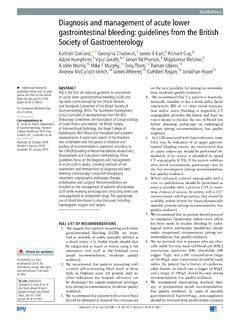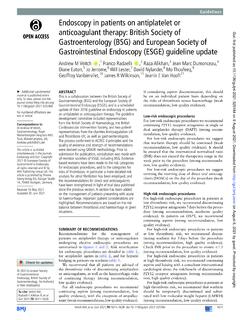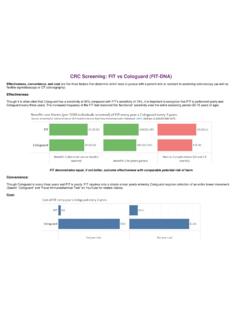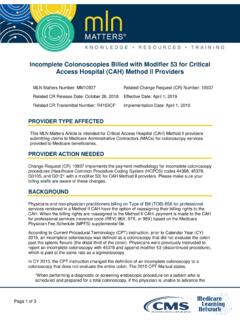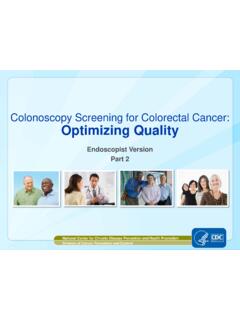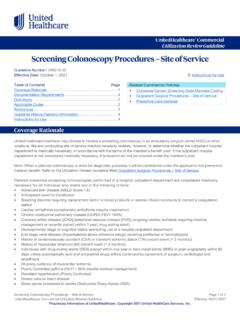Transcription of UK Key Performance Indicators & Quality Assurance ...
1 UK Key Performance Indicators & Quality Assurance Standards for colonoscopy Colin J Rees 1,2,3, Siwan Thomas Gibson4, Matt D Rutter2,3,5, Phil Baragwanath6, Rupert Pullan7, Mark Feeney7, Neil Haslam8 1. South Tyneside NHS Foundation Trust 2. Durham University School of Medicine, Pharmacy and Health 3. Northern Region Endoscopy Group 4. St. Mark's Hospital,London NW Hospitals NHS Trust, Imperial College London 5. University Hospital of North Tees 6. University Hospital of Coventry & Warwickshire NHS trust 7. South Devon Healthcare NHS Foundation Trust 8. Royal Liverpool University Hospital On behalf of: The British Society of Gastroenterology The Joint Advisory Group on GI Endoscopy The Association of Coloproctology of Great Britain and Ireland Corresponding Author: Professor Colin J Rees Address: Department of Gastroenterology South Tyneside District Hospital, South Shields.
2 NE34 0PL Telephone: (0191) 4041000 ext: 4028 E-mail: Introduction colonoscopy is the gold standard investigation for assessment of the large bowel allowing diagnosis, biopsying, and therapy to be undertaken. colonoscopy detects and prevents colorectal cancer[1], and is important tin the diagnosis and treatment of non-neoplastic conditions. colonoscopy can lead to rare but serious complications[2-5] and poor Quality colonoscopy is associated with increased rates of interval cancers[6]. The Quality of UK colonoscopy has improved over recent years[7, 8] but unacceptable variation in practice still exists[8, 9]. Additionally the demand for colonoscopy is increasing[10-13]. In 2013 The Joint Advisory Group on GI Endoscopy, the British Society of Gastroenterology and the Association of Coloproctology commissioned a group to review existing and define new Quality measures and key Performance Indicators for colonoscopy .
3 For each standard a review of existing literature and evidence was undertaken. Where evidence exists it has been used to frame the standards. Where no clear evidence exists then existing standards and expert opinion have been used to arrive at agreed standards. This document establishes clear minimal standards for KPI and QA measures. Where practice falls below these levels then interventions are required to raise the Performance of those colonoscopists. Where the authors believed that higher standards would be ideal an aspirational target has been set. The authors believe that this is the level that all colonoscopists should be aiming for to provide the highest Quality of practice. Summary of Quality standards Quality indicator Minimal standard Aspirational target Comment Caecal intubation rate (unadjusted) 90% 95% Photographic proof of ileocaecal valve, terminal ileum, anastomosis or appendix orifice required in all cases Adenoma detection rate (ADR) in general all patients population (not screening ).
4 15% 20% Adenoma detection rate is the Quality standard. Given the difficulty in reporting ADR then Polyp Detection Rate or Polypectomy rate may be used where it has been demonstrated to accurately reflect ADR for that unit / clinician. Bowel preparation of sufficient diagnostic Quality to not warrant repeat or alternative test. 90 % 95% Rectal retroversion rate 90% colonoscopy withdrawal time (for negative procedures) Mean of 6 mins Mean of 10 minutes Sedation level for age < 70 Median total dose 50mg Pethidine ( 100mcg Fentanyl) 5mg Midazolam (Or equivalent drugs) Auditable outcome Sedation level for age 70 Median total dose 25 mg Pethidine ( 50 mcg Fentanyl) 2 mg Midazolam (Or equivalent drugs) Auditable outcome Number of colonoscopies undertaken by endoscopist (or directly supervising trainee in room)
5 Per year 100 150 If numbers less than 150 then other KPI CIR and ADR should be scrutinised more closely and if concerns identified then action should be taken Polyp retrieval rate 90% Tattooing of all lesions 20mm and / or suspicious of cancer outside of rectum and caecum 100% Tattoo according to trust policy Diagnostic biopsies for unexplained diarrhoea Rectal biopsies taken in 100% of cases Minimum of 2 right and 2 left colon biopsies Post colonoscopy Colorectal Cancer Auditable Outcome All Post colonoscopy Colorectal Cancers (PCCRC) should be reported as adverse events and each unit should have a policy for capturing PCCRC data. Comfort level Auditable Outcome Units should audit this and units should aim to have less than 10 % of patients with moderate or severe discomfort.
6 Overall colonoscopic perforation rate <1 in 1000 <1 in 3000 Diagnostic colonoscopic perforation <1 in 2000 <1 in 4000 Additional Recommendations: 1. Management of polyps all units should have a policy for management of polyps including a policy for dealing with large and large sessile polyps. 2. Tattoo policy - all units should have a policy for tattooing of polyps and cancers and should audit whether this is being followed. 3. Rectal examination should be performed at colonoscopy or prior to endoscopy. rate Colonoscopic perforation rate where polypectomy performed <1 in 500 <1 in 1500 Colonoscopic perforation rate where dilatation performed <3% (<1 in 33) <1% (<1 in 100) Diagnostic FS perforation rate <1 in 5000 <1 in 10,000 Colorectal stenting perforation rate <10% <5% Post polypectomy bleeding rate (intermediate severity or higher) <1 in 200 <1 in 1000 Unplanned admission rate Auditable outcome; Review every case Use of reversal agents Auditable outcome; Review every case 4.
7 Terminal ileal intubation all units should audit practice and agree local policy. Caecal Intubation Rate Minimal caecal intubation 90%. Colonoscopists should aspire to achieve 95% caecal intubation. Photographic documentation of caecal intubation should be obtained with images taken of clear caecal landmarks or of terminal ileum. It is important to examine the whole colon, but practice is variable[7, 14, 15]. The consequences of an incomplete examination are missed diagnosis and failure to prevent interval cancers[16, 17]. In a British Society of Gastroenterology (BSG) audit of all colonoscopies performed within the UK over a 2 week period[8], the unadjusted Caecal Intubation rate was rising to following adjustment for impassable strictures and poor bowel preparation.
8 A further UK study[9] demonstrated an unadjusted CIR at (95% CI ). The English Bowel Cancer screening Programme (BCSP) published the results of the first 3 years of screening [18] with an unadjusted CR of (range 100%). Given the caecal intubation rate in excess of 90% for large series this should be the minimal standard. The BCSP demonstrates that a higher caecal intubation rate can be achieved in a large programme and a standard of 95% should be aspired to. Adenoma Detection Rate Minimal Adenoma Detection rate should be 15%. Aspirational adenoma detection rate should be 20% Where Polyp detection rate can be shown to be accurate it maybe used as a marker of ADR. Thorough examination of the colonic mucosa is crucial to maximise the effectiveness of colonoscopy as a diagnostic test.
9 The ADR is the marker most commonly used for this purpose. Lower ADRs are associated with higher rates of interval cancers[6, 19]. Colonoscopists with an ADR less than 20% had a hazard ratio (HR) for interval cancer that was ten times higher than colonoscopists with an ADR of greater than 20%. A recent UK study demonstrated wide variation in ADR with a global ADR (excluding screening colonoscopy ) of [9]. The data indicates that the current 10% UK minimum is too low. The 20% ADR reported by Kaminski et al[6] is aspirational, but was for a screening age population. Based upon the available UK population study for a population of all ages a standard of 15% has been set with an aspirational target of 20%.
10 Measuring ADR currently requires interrogation of pathology databases to obtain polyp histology. The polyp detection rate (PDR) is often much more simple to obtain. ADR is the key Performance measure but where it can be demonstrated that a ratio between an endoscopist s PDR and ADR has been developed and validated, then PDR may be an acceptable surrogate marker[20-22] with the minimum value set to ensure an ADR of 15% (20% aspiration) is achieved. It is recommended that review of the validity of PDR to represent ADR is audited on an ongoing basis. Bowel Preparation Bowel preparation of at least adequate Quality to be achieved in 90% of patients. Aspirational: bowel preparation of at least adequate Quality to be achieved in 95% of patients.
